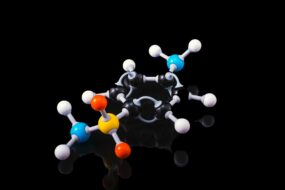Acetazolamide is a sulfonamide derivative that noncompetitively inhibits carbonic anhydrase in the proximal convoluted tubules.
Rapidly absorbed orally and eliminated in urine.
Mechanism of action.
- Carbonic anhydrase inhibitor causes carbonic acid accumulation by inhibiting its breakdown.
· In the eyes, it decreases the aqueous humor formation rate, reducing intraocular pressure.
· In the kidneys, it inhibits H+ ion excretion, increasing sodium, potassium, bicarbonate, and water elimination and producing alkaline diuresis.
· In the CNS, it inhibits carbonic anhydrase, decreasing abnormal and excessive discharge from the CNS neurons.
Clinical uses.
- Alkalinization of urine: for urinary tract infection or to promote excretion of certain acidic drugs from the body.
- Epilepsy: in absent seizures
- Glaucoma: as an adjuvant to other ocular hypotensives.
- Acute mountain sickness: for symptomatic relief and also prevention.
- Periodic paralysis.
Adverse effects.
- Acidosis, hypokalaemia, drowsiness, fatigue, paresthesias, and abdominal discomfort.
- Hypersensitivity reactions—fever, rashes.
- Bone marrow depression.
- Loss of appetite, flaccid paralysis, and glycosuria.
- May cause impotence.
Contraindication.
- Liver disease may precipitate hepatic coma by interfering with the urinary elimination of ammonia.
- COPD:acidosis may occur.
- Hypersensitivity to sulphonamides.
- Adrenocortical insufficiency.
Drug interaction.
- Salicylate levels increased at moderate doses hence the risk of CNS toxicity.
- The drug decreases levels of primidone by inhibiting its GI absorption.
Dosage.
- 250 mg OD–BD; DIAMOX, SYNOMAX 250 mg tablet.
- IOPAR-SR 250 mg SR capsule.












